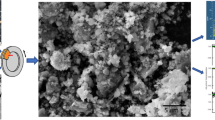Abstract
Although a lot of studies were performed about wear debris, there is a lack of procedures that can identify and measure the size and size distribution of the generated debris. To find a more precise and innovate method characterizing wear debris size, average size, and size distribution measurements, the j image software program is applied as a consequence to sieving, optical microscope photography, and computer aided sorting processes. The wear investigates are carried out on a pin-on-disc test machine under dry sliding situations for the brass pins against steel disc type EN 31 under five different loads. The results demonstrate that the usage of the above-stated sequence of processes is a reliable technique that leads to obtaining more accurate results of the required measurements for all types of the generated debris.














Similar content being viewed by others
References
Amirat M, Zaïdi H, Frêne J (2008) A study of contact temperature and tribological behaviour of magnetized sliding brass–steel couple in different gas environments. Proc Inst Mech Eng Part J 222:279–290. https://doi.org/10.1243/13506501JET358
Elliot D, Segmentation of wear particle images from used oil filtergrams, ACCV2002: The 5th Asian Conference on Computer Vision, January 2002, Melbourne, Australia, pp. 23–25
Ge S, Guoan C, Xiaoyun Z (2001) Fractal characterization of wear particle accumulation in the wear process. Wear 251(1–12):1227–1233
Ghosh S, Sarkar B, Saha J (2005) Wear characterization by fractal mathematics for quality improvement of machine. J Qual Maint Eng 11(4):318–332
Hong L, Haijun W, Lidui W, Jingming L, Zhiyuan Y (2016) The segmentation of wear particles images using -segmentation algorithm. Adv Tribol. https://doi.org/10.1155/2016/4931502
Ibrahim AA (2008) Wear particles surface identification using neural network. Int J Comput Sci Netw Secur 8(1):262–265
Jia F, Yu F, Song L, Zhang S, Sun H (2020) Intelligent classification of wear particles based on deep convolutional neural network. J Phys: Conf Ser 1519:
Jingqiu W, Xiaolei W (2013) A wear particle identification method by combining principal component analysis and grey relational analysis. Wear 304(1–2):96–102
Khan MA, Starr AG (2006) Wear debris: basic features and machine health diagnostics. Insight Non-Destruct Test Cond Monit 48(8):470–476. https://doi.org/10.1784/insi.2006.48.8.470
Kučera M, Aleš Z, Pexa M (2016) Detection and characterization of wear particles of universal tractor oil using a particles size analyzer. Agron Res 14(4):1351–1360
Kumar M, Mukherjee PS, Misra NM (2013) Advancement and current status of wear debris analysis for machine condition monitoring: a review. Ind Lubr Tribol 65(1):3–11
Laghari MS, Khuwaja GA (2013) Scheduling techniques to classify wear particles on multi-computers. Int J New Comput Arch Appl 3(1):52–71
Macián V, Tormos B, Olmeda P, Montoro L (2003) Analytical approach to wear rate determination for internal combustion engine condition monitoring based on oil analysis. Tribol Int 36(10):771–776
Mahdavian SM, Mai YW, Cotterel B (1982) Friction, metallic transfer and debris analysis of sliding surfaces. Wear 82(2):221–232
Manoj K, Mukherjee PS, Misra NM (2013) Statistical hypothesis testing of the increase in wear debris size parameters and the deterioration of oil. Int J Eng Invent 2(8):01–08
Marián K, Aleš Z (2017) Morphology analysis of friction particles generated in tractor transmission oils. Acta Technologica Agriculturae 20(3):57–62
Melik C (2009) Wear behaviour of Cuzn34al2 brass material. Technology. 12(4):227–233
Mohammad SL, Faheem A. IEEE International Conference on Signal Processing Systems-Singapore 2009 International Conference on Signal Processing Systems-Wear Particle Profile Analysis, (2009), pp. 546–550. https://doi.org/10.1109/icsps.2009.152
Mohammad LS, Qurban AM, Gulzar AK (2004) Knowledge based wear particle analysis. Int J Inf Technol 1(3):91–95
More PP, Jaybhaye MD (2019) Evaluation of effective area of wear particles using image. Int J Eng Adv Technol 8(5):1646–1650
Myshkin NK, Kong H, Grigoriev AY, Yoon ES (2001) The use of color in wear debris analysis. Wear 251(1–12):1218–1226. https://doi.org/10.1016/s0043-1648(01)00751-7
Peng Z, Goodwin S (2001) Wear-debris analysis in expert systems. Tribol Lett 11(3–4):177–184
Peng Z, Kirk TB (1998a) Automatic wear-particle classification using neural networks. Tribol Lett 5:249–257
Peng Z, Kirk TB (1998b) Computer image analysis of wear particles in three-dimensions for machine condition monitoring. Wear 223:157–166
Peng Z, Kirk TB (1999) The study of three-dimensional analysis techniques and automatic classification systems for wear particles. J Tribol 121(1):169–176. https://doi.org/10.1115/1.2833799
Peng DQ, Xu F (2010) Classification of wear debris using weighted fuzzy cluster method. Appl Mech Mater 33:70–73
Reintjes J, Tucker JE, Thomas SE, Schultz A, Tankersley LL, Lu C, Howard PL, Sebok T, and Holloway C, Laser net fines wear debris analysis technology: application to mechanical fault detection, [Aip Review of Progress in Quantitative Nondestructive Evaluation: Volume 22-Bellingham, Washington (USA) (14-19 July 2002)] AIP Conference Proceedings, (2003), CP657, pp 1590–1597. https://doi.org/10.1063/1.1570320
Roman J, Stanislav M, Pavel Z, Analysis of wear debris through classification. Conference Paper. 2011
Ruff Chiba AW. Metallurgical analysis of wear particles and wearing surfaces, Prepared for Department of the Navy Office of Naval Research Arlington, Virginia 22217 Naval Air Engineering Center Philadelphia, Pa. 19112, (April 1974)
Sharma A, Kumar A, Sharma S, Priyavatsh S, Ghosh SK (2017) Morphological characterization of wear debris from the transmission dystem of dumper. Int J Adv Res. 5(4):1079–1083
Shufa Y, Biao M, Changsong Z (2019) A unified system residual life prediction method based on selected tribodiagnostic data. IEEE Access 7:44087–44096. https://doi.org/10.1109/access.2019.2908659
Sondhiya OP, Gupta AK (2012) Wear debris analysis of automotive engine lubricating oil using by ferrography. Int J Eng Innov Technol 2(5):46–54
Wei H, Wenjian C, Shaoping W, Tomovic MM (2017) A review for mechanical detection and diagnosis. Chin J Aeronaut. https://doi.org/10.1016/j.cja.2017.11.016
Standard Test Method for Wear Testing with a Pin-on-Disk Apparatus, Copyright © ASTM, 2000
Z Alfred (2005) Wear debris: a review of properties and constitutive models. J Theor Appl Mech 43(1):3–35
Author information
Authors and Affiliations
Corresponding author
Ethics declarations
Conflict of interest
The author declares that there is no conflict of interest.
Additional information
Publisher's Note
Springer Nature remains neutral with regard to jurisdictional claims in published maps and institutional affiliations.
Rights and permissions
About this article
Cite this article
Yagoob, J.A. Analysis of generated wear debris of brass during dry sliding. Appl Nanosci 13, 539–547 (2023). https://doi.org/10.1007/s13204-021-01835-2
Received:
Accepted:
Published:
Issue Date:
DOI: https://doi.org/10.1007/s13204-021-01835-2




